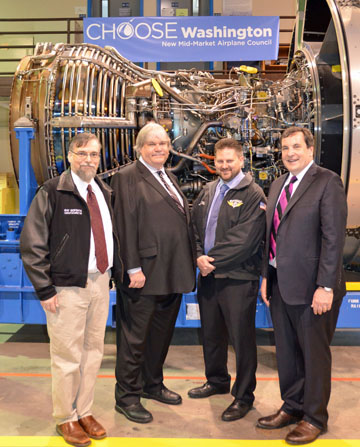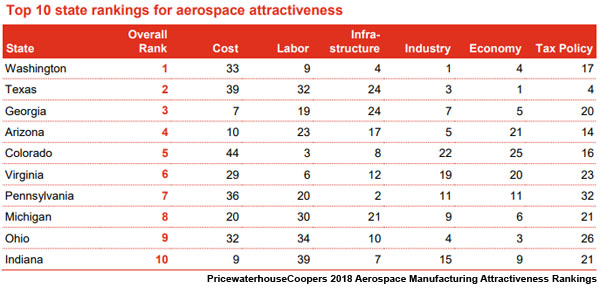STATE GOVERNMENT
Washington ranked #1 (again) for aerospace manufacturing
New study ranks state as best place on the planet for aerospace manufacturing
By DAVID GROVES
The Stand
SEATTLE (Sept. 13, 2018) — In June, an internationally respected aerospace analyst released the most comprehensive data-driven aerospace competitiveness study ever performed. It found that Washington state is — by far — the best location in the United States to design, manufacture and ensure a successful launch of Boeing’s next airplane. But some officials from other states competing for the New Middle-Market Airplane (NMA) scoffed at the study’s conclusion because it was funded by Washington state.
 This month, a new analysis released by PricewaterhouseCoopers (PwC), a multinational business and tax consulting firm based in London, finds that Washington state is the best location in the world for aerospace manufacturing. Its analysis of “aerospace manufacturing attractiveness” found the United States to be the best nation and Washington to be the best state.
This month, a new analysis released by PricewaterhouseCoopers (PwC), a multinational business and tax consulting firm based in London, finds that Washington state is the best location in the world for aerospace manufacturing. Its analysis of “aerospace manufacturing attractiveness” found the United States to be the best nation and Washington to be the best state.
The PwC report uses multiple metrics and data points to create “a guide to promising geographic locations for aerospace development… Our quantitative framework can help provide industry leaders with information to optimize the supply chain, control costs, and plan for future growth.”
“Washington topped the state ranking this year,” the report reads, “with high marks in the categories of industry, infrastructure, and economy.”
Notably, South Carolina, the only other state with a Boeing airplane manufacturing factory, didn’t even rank in the Top 10 of the PwC study.
The PwC’s study echoed the conclusion of the June study performed by aerospace analyst Richard Aboulafia of the Teal Group. The Aerospace Competitiveness Economics Study or “Teal Report” showed Washington far ahead of other states as the most competitive place for large aerospace manufacturing operations. According to the report, Washington would offer the lowest risk and highest return for Boeing should the company choose to build its proposed NMA here.
“Washington comes way out on top,” Aboulafia said. “People can look at the data themselves and get the same outcome.”

SPEEA Executive Director Ray Goforth, SPEEA President Joel Funfar, IAM 751 President Jon Holden, and Richard Aboulafia of the Teal Group.
Gov. Jay Inslee said the state is well-positioned for the new airplane because of the extreme depth of experience and expertise offered by Boeing Machinists (IAM District 751) and engineers (SPEEA/IFPTE 2001). He said much of Washington’s success in aerospace is because of the stellar 136,000 aerospace workers — many from second- and third-generation aviation families — who call our state home.
“From the 737 to the 787 Dreamliner, we are proud that Boeing’s roots are in Washington,” Inslee said. “We believe we have all the ingredients necessary to bring the NMA to market quickly and profitably, thanks to our expert workforce and our century-long legacy of building aircraft of exceptional quality.”
Though wages may be lower in other locations, the study used common data points to weigh productivity as a factor in the cost.
“The Teal Report looks not just at the basic cost of the labor, but they also looked at the output of that labor,” said IAM 751 President Jon Holden. “What they found is that machinists and engineers here in Washington are very efficient and productive. We produce more aerospace output per dollar cost of labor than almost anywhere else.”
SPEEA President Joel Funfar emphasized that point: “It’s a lot cheaper when you do it right the first time,” he said. “It is very clear when you look at all the factors that Washington is the best place to ensure success for the NMA.”

An artistic rendering made by Boeing of the NMA. (Source: jonostrower.com)
Washington’s aerospace industry, according to the study, produces more revenue, exports and profits than any other state in the nation. Washington has the largest number of aerospace workers, the highest density of aerospace engineers, second-highest density of aerospace production workers and fourth-lowest unit labor costs.
In addition, Washington has advantages beyond those pertaining to just aerospace, including low energy costs, high port volume, low insurance losses, higher number of patents per capita, considerable private research and development investments, and lower taxes.

Other key findings from the study include:
- Every dollar paid to workers in Washington’s aerospace industry generates $11 in revenue, so Washington has the fourth-lowest unit labor costs in the nation.
- Washington has the lowest industrial energy prices in the nation.
- Washington ranks second in labor and education, based on the availability of aerospace workers, the population’s educational attainment and state spending on K-12 education.
- In 2017, Washington exported more aerospace products and parts than California, Texas, Georgia, Florida, South Carolina, Arizona and Alabama combined.
- Washington is a leading state in research and innovation, with the third-highest patents per capita and fifth-highest rate of private research and development investments in the nation.
 The Choose Washington NMA Council, led by business, labor, education, economic development and elected leaders, commissioned the Teal Report. The council, co-chaired by Washington State University engineering professor Noel Schulz and former Washington State Labor Council president Rick Bender, met recently in Spokane and Pierce County to discuss how aerospace companies in those communities contribute to the supercluster.
The Choose Washington NMA Council, led by business, labor, education, economic development and elected leaders, commissioned the Teal Report. The council, co-chaired by Washington State University engineering professor Noel Schulz and former Washington State Labor Council president Rick Bender, met recently in Spokane and Pierce County to discuss how aerospace companies in those communities contribute to the supercluster.
“Washington is not number one by accident. I feel strongly that our manufacturing infrastructure here is successful and has been made so because of the many stakeholders who have made important investments in our state over the last 100 years,” said IAM’s Holden.







